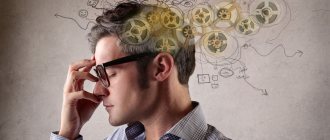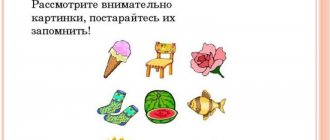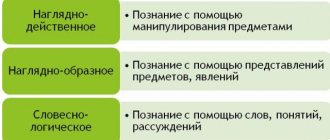What is a cognitive set?
Each person perceives the world differently.
The perception of people, situations and events is an active process that occurs through a certain filter. Each person has a certain prism through which everything that happens is distorted. This bias is an attitude. Cognitive means thinking. Cognitive attitude is a formed mental image, stereotype, model.
Attitudes guide our behavior and determine the course of our thoughts. How a person reacts to a certain event, whether positive or negative emotions arise, is determined by attitudes.
The installations act as a filter for incoming information.
Attitudes are established in childhood and continue to develop throughout life. They depend on the social environment in which a person lives.
Reaction test
On the graph, the horizontal axis shows the test results in seconds (only results better than 1 second are taken into account).
The vertical axis shows the number of tests passed with a given result. How quickly can you react if necessary? The ability to react quickly can be critical in different situations. This test allows you to determine your reaction time - when the traffic light turns green, you need to immediately press the mouse button.
Attitudes can be rational or irrational.
Rational attitudes are useful , help to survive and improve the quality of life, protect the psyche from emotional stress and worries. For example: “I have the right to make mistakes. It's impossible to be perfect. I am a person, not a robot, I can be sad, cry and grieve. I can't influence others."
Irrational attitudes contain cognitive errors—errors in thinking. They can provoke stress, reduce quality of life, and make it difficult to adapt to new situations.
Each person has their own “cognitive vulnerability” - a weak point that determines their susceptibility to stress.
Cognitive attitudes can be noticed by observing one's thoughts and judgments. By perceiving oneself as a being who “thinks thoughts themselves” (and not “thoughts themselves think”), one can find thinking errors. Then challenge those erroneous ideas, correct them, and replace them.
Cognitive and affective processes
Cognitive processes are mental processes that perform the function of rational cognition (from the Latin cognitio - knowledge, cognition, study, awareness).
The concept of “cognitive”: cognitive processes, cognitive psychology and cognitive psychotherapy - became widespread in the 60s of the 20th century, during the fascination with cybernetics and electronic modeling of intellectual processes, which grew into the habit of imagining a person as a complex biocomputer. Researchers have tried to model all mental processes occurring in humans. What we managed to model was called cognitive processes. What didn’t work out was affective.
Thus, in fact, the concept of “cognitive processes” received a similar, but slightly different meaning. In practice, “cognitive” refers to mental processes that can be represented as a logical and meaningful sequence of actions for processing information.
Or: which can be reasonably modeled in terms of information processing, where logic and rationality can be discerned in information processing.
Cognitive processes usually include memory, attention, perception, understanding, thinking, decision-making, action and influence - to the extent or to the extent that they are occupied by cognitive processes and not by something else (drives, entertainment...). To greatly simplify, we can say that this is competence and knowledge, skills and abilities.
Affective processes are mental processes that cannot be reasonably modeled. First of all, these are the processes of an emotional and sensory attitude to life and interaction with the world, oneself and people. Also, to simplify, these are usually feelings and premonitions, desires and impulses, impressions and experiences.
For example
Rational perception is an analytical, critical perception, different from intuition and living impression. “The ice cream is delicious, but it’s not the right time for a sore throat. Let’s put it off!”
Rational understanding is understanding through concepts and logic, as opposed to empathy, empathy and feeling, that is, emotional, bodily and experiential ways of understanding.
Rational influence is explanation and persuasion that appeals to a person's reason. Suggestion, emotional contagion, anchoring and other means that influence a person in an unreasonable way are classified as irrational means of influence.
Rational thinking is logical and conceptual thinking, or at least directed in this direction. People in the process of life and communication do not always think, quite successfully making do with feelings, habits and automatisms, but when a person turns on his head, he thinks (at least tries to think) rationally. See Rational and irrational thinking
Cognitive processes and emotions
Emotions are classified primarily as affective processes, since they are difficult to model rationally.
No one knows what emotion a woman will sometimes express, including herself...
On the other hand, some emotions arise quite naturally, as a result of understandable programs, established habits or certain benefits. In this case, such emotions can be attributed to cognitive processes, or, in another language, the cognitive component of such emotions can be studied.
Rational and emotional
On the complex relationships between the rational and the emotional, see
List of irrational attitudes
- Installation of must
| I must | I'm owed | The world around us should (weather, government, economy) |
Probably the most stressful installation. Is it easy to live if a person himself constantly has to meet some criteria, and the people around him also owe something?
- Installation of catastrophizing
Some event is perceived as a “universal catastrophe” without the possibility of correction and change. Making a mountain out of a mountain.
"Nightmare, horror, disaster"
- Installation of predicting a negative future
The habit of predicting failures, exaggerating, imagining the worst. A person does not criticize his predictions; supposedly only a negative outcome is possible.
“What if, what if, it could be”
- Maximalism setting
Prescribing the highest standards, sometimes even unattainable. The extreme degree of such judgments is perfectionism.
“All or nothing”, “either the best or worthless”, “everything to the maximum, 100%”
- "Black and white thinking" attitude
Tendency to think in extremes.
“either-or, either-or”, “You are either a winner or a loser.”
- Setting up personalization
Tendency to associate events with oneself.
“Everyone is looking at me,” “Those men are judging me now.”
- Overgeneralization setting
Create a general rule based on one or more individual episodes.
“All men are goats”, “All blondes are stupid”, “I can’t solve a problem, so physics is not for me”, “Something bad always happens to me.”
“everyone, always, never, no one, constantly, forever.”
- Mind Reading Installation
“He’s thinking about me now...”, “My boss is frowning because he’s unhappy with me,” “He’s probably offended because...”
- Evaluation installation
When a person evaluates another as a whole. Based on one character trait, assumptions are made about the entire personality.
“Bad-good”, “stupid-smart”, “reasonable-reckless”, “evil-good”.
- Anthropomorphism setting
Attribution of human properties and qualities to objects of living and inanimate nature.
"It's raining because he wants me to stay home"
NeuroNation
An interesting course with interestingly illustrated tasks that are more like a game. Gamification of training encourages greater engagement for maximum effectiveness.
At the beginning of the training, you will be asked to answer 11 questions that will allow you to build a personalized training plan that matches your goals and current level of performance.
Preparatory tasks to assess your level of working memory control are provided free of charge.
By the way, there is also a Russian analogue - the Vikium service.
Vikium
Vikium suggests first taking a test and determining the quality of your thinking. Based on the test results, you receive a training program. The course consists of daily 15-minute lessons.
The service operates on a freemium model: users can purchase access to all courses, specialized tasks, and the opportunity to compete with other participants. A premium account costs 1,990 rubles per year.
The project website states that solving the proposed puzzles will help you stop being distracted by external interference and irritants, teach you to quickly switch between different types of activities, concentrate on tasks and work more productively. The company even has games that work with a device that reads the electrical activity of the brain (alpha rhythm and beta rhythm) - you need to work with them with full concentration and in absolute calm.
Development of cognitive abilities
The human brain, as a structure of interacting neurons, is very plastic and adapts to changes in external conditions and to the goals that its owner sets for himself.
If you set a goal, then regular training can lead to truly impressive results. You can act in standard ways, for example, learning long poems by heart or solving mathematical problems, or you can combine familiar methods with original ones.
Brain Metrix
But this is a real game, but it was created “according to the precepts” of neuroscientists. The one who can well predict the exact place where the ball will go will be able to show a high result. When playing, try not to focus on where the ball is, but try to predict where it might end up.
On the site you will find other free games against the computer that will help your brain better operate working memory. In some cases, they will immediately tell you the number of points, after which you do not need to continue the game - you have already achieved perfection.
How to develop cognitive thinking
Development of attention - exercises for training concentration
Note! Cognitive thinking can be developed at any age. New information and the desire to learn new skills will allow you to constantly develop cognitive thinking.
Children's cognitive abilities can be developed in the following ways:
- For the youngest children, games for fine motor skills are suitable, including the use of beads, cereals, and buttons. You can sort through small objects or let your baby pour from one container to another;
- Older children will benefit from puzzles, construction sets, and mosaics, the complexity of which should be increased as they grow older. Drawing, coloring, cutting out are useful. Then you can memorize poems, retell them, compose stories from pictures or based on suggested phrases.
Children putting together a puzzle










